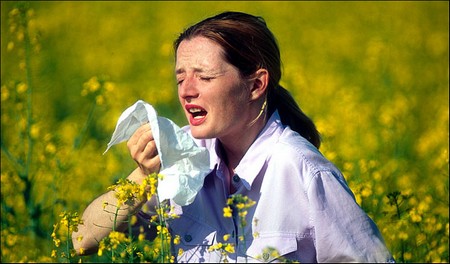For many people, an allergy to pollen makes the spring, summer and/or autumn (fall) months a misery, confining them inside their homes with the windows and doors firmly shut. Although we think of brightly coloured garden plants as being the main pollen-producing culprits, many of the pollens produced by these flowers and flowering shrubs are too large for wind dispersal and do not, therefore, give rise to problems, unless you come very close to them. In fact, the major group of pollen sources associated with asthma, rhinitis, and conjunctivitis are tree, grass, and weed pollens.
Tree pollens
Trees are the first pollen producers of the year releasing their showers of golden dust from the late winter and early spring through to the early summer In Europe and the USA, depending on the distribution of species, the following trees may be associated with pollen allergy:
- Acer (Box elder)
- Acer (Maple)
- Acer (Sycamore)
- Alnus (Alder)
- Betula (Birch)
- Carya (Hickory)
- Castanea (Chestnut)
- Cedrus (Cedar)
- Corylus (Hazel)
- Cupressus (Cyprus)
- Fraxinus (Ash)
- Juglans (Walnut)
- Olea (Olive)
- Populus (Poplar)
- Quercus (Oak)
- Salix (Willow)
- Ulmus (Elm)
The pollination of trees depends on the ambient temperature and hours of sunlight, and since these factors are variable from year to year, so, too, is the amount of pollen produced. Typically, however the pollen season for each tree species lasts about three or four weeks.
Weed pollens
Just when you think you are safe and can finally open your windows once again, having survived both the tree-and grass-pollen seasons, next it is the turn of the numerous weed species to add their pollen load to the air you breathe in.
The plant with one of the longest periods of pollination is the common dock weed (Rumex). This perennial weed begins pollinating in the early summer and does not finish until the mid autumn (fall).The weeds that are associated with the most significant problems are:
- Ambrosia (Ragweed)
- Artemesia (Mugwort)
- Parieteria (Nettle)
- Parieteria (Wall pellitory)
- Plantago (Plantain)
- Rumex (Dock)
- Rumex (Sorrel)
Ragweed (Ambrosia) is a prolific pollen producer and its pollen season in the northern hemisphere runs from August to November (or until the first frost, whichever is sooner), and levels peak in mid September in many areas. Each plant produces about a billion pollen grains in a season and these have been detected 600 km/370 miles out at sea. Studies have shown that ragweed pollen is a very powerful allergen, with fewer grains needed to produce a hay fever attack than with other allergens. Another significant plant is the wall pellitory which also produces large amounts of a highly potent pollen.
Thunderstorm asthma
There are worldwide reports of severe asthma attacks occurring in association with thunderstorms during the hay-fever season. These attacks happen in individuals who suffer from hay fever but who do not usually experience asthma. It has been shown that grass pollens rupture in the high humidity preceding a storm, releasing large numbers of starch granules containing allergen. While pollen grains themselves are too large to be inhaled into the airways, these starch particles, either alone or bound to airborne particulates (such as diesel exhaust carbon particles), can readily be inhaled into the airways and induce an allergic reaction leading to asthma.
On occasions when “thunderstorm asthma” has occurred, pollen counts have been high and the high humidity has led to a great increase in starch granules containing allergen within the air Sufferers need to be aware and stay inside if the weather forecast is bad.
Categories
Advertisements
Recent Articles
 How to Understand Bed Sizes – A Small Guide
How to Understand Bed Sizes – A Small Guide How to Select Some Must Have Kitchen Accessories
How to Select Some Must Have Kitchen Accessories Best Way to Change a Car Tire
Best Way to Change a Car Tire Best Way to Write an Affirmation
Best Way to Write an Affirmation Best Way to Take Charge of Your Financial Life
Best Way to Take Charge of Your Financial Life Best Way to Survive a Party When You Don’t Know Anyone
Best Way to Survive a Party When You Don’t Know Anyone Best Way to Stop Self Sabotaging Yourself
Best Way to Stop Self Sabotaging Yourself Best Way to Start Journal Writing
Best Way to Start Journal Writing Best Way to Speak with a Powerful Voice
Best Way to Speak with a Powerful Voice Best Way to Simplify Your Life
Best Way to Simplify Your Life Best Way to Respond to a Put-Down
Best Way to Respond to a Put-Down Best Way to Reduce Acne Breakouts
Best Way to Reduce Acne Breakouts Best Way to Recover from Dining Disasters
Best Way to Recover from Dining Disasters Best Way to Quit Your Job Gracefully
Best Way to Quit Your Job Gracefully Best Way to Make Your Own Website
Best Way to Make Your Own Website




Leave a Reply